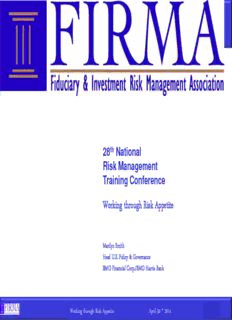
Working through Risk Appetite PDF
Preview Working through Risk Appetite
28th National Risk Management Training Conference Working through Risk Appetite Marilyn Smith Head U.S. Policy & Governance BMO Financial Corp./BMO Harris Bank Fiduciary Governance April 30 • 2013 · 0 Working through Risk Appetite April 30 2014 Disclaimer The views and opinions expressed in this presentation are those of the speaker and do not necessarily reflect those of the employer, its affiliates, or any other organization. Reference to any specific commercial product, process, or service by trade name, trademark, or otherwise does not necessarily constitute or imply its endorsement, recommendation, or favoring by the speaker’s employer. The information provided and the views and opinions expressed in this presentation are drawn solely from the speaker’s own experience and years of expertise in the financial services industry, and may not be not attributable to any particular organization. · 11 Working through Risk Appetite April 30 2014 Session Objectives • Why Risk Appetite? • Developing the Risk Appetite Statement • Risk Tolerances/Key Risk Indicators • Reviewing the Risk Appetite Process · 22 Working through Risk Appetite April 30 2014 Industry Definitions Risk Appetite Level and type of Risk the firm is able and willing to assume Risk Capacity Upper level and type of risk where firm can operate and remain within tolerances (should have no intentions of ever reaching) Risk tolerance Upper and lower limits within which the firm targets (usually set as a buffer between appetite and capacity) Risk Profile Point-in-time assessment of the actual risk related to a firm’s exposures and business activities · 33 Working through Risk Appetite April 30 2014 Why Risk Appetite? Regulatory Responsibilities for Risk Management Fed Members Non-members National Bank Supervision “Risk ratings must be applied “..conduct risk management to all state member banks examinations based on the “consider the risk profile and and bank holding companies risk profile of the institution.” assign regulatory ratings” regardless of size…” Trust Companies UITRS (Uniform Interagency Trust Rating System) “…emphasize the quality of the risk management process in each of the ratings components…” · 4 Working through Risk Appetite April 30 2014 Why Risk Appetite? Regulatory Dodd-Frank Act : Enhanced Prudential Standards for Systemically Important Financial Institutions (SIFIs) “..Maintain a clearly articulated corporate strategy and institutional risk appetite.” / introduction of early remediation plans February 18, 2014 FRB Final Rule on Enhanced Prudential Standards for US BHCs & FBOs set enhanced requirements for risk management, and capital stress testing January 2014 OCC Proposed Heightened Supervision Guidelines “”The third expectation pertains to risk appetite (or tolerance) and involves institutions defining and communicating an acceptable risk appetite across the organization, including measures that address the amount of capital, earnings, or liquidity that may be at risk on a firm-wide basis, the amount of risk that may be taken in each line of business, and the amount of risk that may be taken in each key risk category monitored by the institution.” January 2010 OCC Large Bank Supervision Handbook “Strong” risk management processes · 5 Working through Risk Appetite April 30 2014 Why Risk Appetite? Industry SOX (Sarbanes-Oxley Act) 2002 Enhanced financial standards for public companies and their accounting firms. Created the PCAOB (Public Company Accounting Oversight Board) COSO (Committee on Sponsoring Organizations of the Treadway Foundation) Common internal control models for assessing the status of your company’s governance, business ethics, internal controls, enterprise risk management fraud and financial reporting. Supported by the American Accounting Association, American Institute of Certified Public Accountants, Institute of Management Accountants, Institute of Internal Auditors and Financial Executives International. Basel: Committee on Banking Supervision/core Principles for Effective Banking Supervision/Risk Management Practices for International standard for determining a bank’s capital needs to guard against financial and operational risk. Financial Stability Board Establishes international standards for the effective implementation of regulatory, supervisory, and financial sector policies for significant financial institutions. · 6 Working through Risk Appetite April 30 2014 Why Risk Appetite? 10 Great Benefits 1. Fosters awareness of the firm’s risk culture 2. Helps management articulate the outcome of the business strategies more clearly 3. Provides clarity and basis around the risk position 4. Ensures some level of consistency in risk decisions 5. Drives consensus across the firm in making decisions about what products/services to offer 6. Embeds a consistent set of values within the firm 7. Mitigates future crisis and impact on reputational risk, service disruption 8. Reduces risk and liability 9. Increases customer satisfaction and profitability 10. Provides a systemic, disciplined way for firms to better think about what they are doing and what drives your performance … (Roger W. Ferguson, Jr., Vice Chairman Board of Federal Reserve System 1999-2006/ TIAA-Cref CEO) · 7 Working through Risk Appetite April 30 2014 Developing the Risk Appetite Statement Characteristics Represents high-level overarching opinion of how much risk your organization is willing to take Generally expressed in the form of a ‘statement’ or multiple statements Statements can be Qualitative and Quantitative / Principles or Performance / Efficiency or Revenue Intended to be ‘forward-thinking’ · 88 Working through Risk Appetite April 30 2014 Sample1 RAS Risk Appetite Statements “To be effective, We proactively take and manage risk. Our philosophy is to invest significant effort in understanding the nature and potential outcomes of the risks we take, and to incorporate those risks into how we price our products, consider and design new practices, and execute our business on a daily basis. We strive to embed this philosophy at all levels of our organization so that anyone, at any time can and should call attention to risks that may not be obvious and ensure that they are fully assessed and taken into account.” · 9 Working through Risk Appetite April 30 2014
Description: